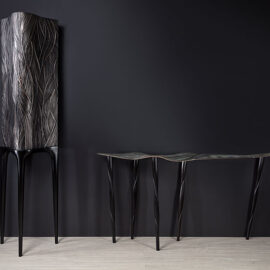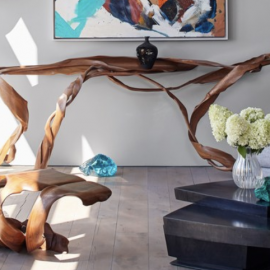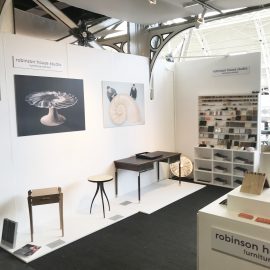There are so many directions students can go in once they finish studying with us, so we thought we would start highlighting a few of our alumni students and share with you what they’ve been up to since graduating.
Laurent Peacock graduated from robinson house studio a couple of years ago now, and we’re pleased to see he has gone on to launch a successful career, working on a lot of exciting projects! We spoke to him about how he developed as a designer and maker, how the school helped to prepare him for his new career, and what he’s been working on since graduation.
1. When did you study at robinson house studio?
I completed the one year course, from May 2016 to May 2017.
2. What did you learn from the projects you made at robinson house studio?
I made a point of ensuring that all of my studio projects were very different from each other, giving me exposure to as wide a range of materials, techniques and processes as possible within the time available. I wanted to be confident, before leaving the relative safety of being a student, that I’d given myself the opportunity to make pieces out of both solid timber and veneered panels, incorporating curved laminations, hinged doors, piston-fit drawers, cabinetry, hand-cut and machine-cut joinery as well as making my own metal components and working with a number of different wood species and finishes.
Each of my two main projects – ‘Sika’ and ‘Aesculus’ – were designed to be constructed in just about the most difficult ways possible, so as to pose problem-solving challenges at every step along the way. I find the problem-solving side of designing and making to be both one of the most enjoyable elements and also the best way of learning. The range of experiences I accumulated on the course, whilst by no means exhaustive, gave me the confidence I felt I needed to graduate out into the real world and start designing and making pieces which people would be happy to spend their hard-earned money on.
3. How did the school help you to develop your portfolio?
From a design perspective, I found the critiquing and feedback available from Marc and the rest of the RHS team to be of great help. There are so many decisions, both major and minor, that need to be made when designing high-end furniture, from overall shape, form and function through size and proportions to materials and detailed construction methods. It’s essential that each and every one of these aspects is carefully considered and any immediate ideas challenged and evaluated to see if they can be improved upon. The push, from Marc in particular, to justify each design decision on a piece was at first a little uncomfortable, but I found it by far the best way to improve both the specific design and my process more generally.
I was extremely happy with the set of pieces I graduated from the course with. The obvious highlight for me was being awarded a Bespoke Guild Mark for my ‘Sika’ console table, which was the first piece of furniture I designed on the course. To have received this coveted external and independent recognition of the skills I’d developed so early on in my furniture-making journey is a point of real pride and achievement for me.
4. How did you get started as a maker after graduating from the school?
After graduation I worked with Marc for a few months on his Vortex table. This was a great opportunity as I was able to gain further experience working on high-end laminated pieces whilst also affording me access to the workshop in my spare time in which I could develop further design ideas and conduct materials experiments without the immediate pressure to become ‘commercial’. This period was very useful for me and some of the materials I produced samples for at that time have gone on to feature in some of my more recent exhibition pieces. I eventually bit the bullet though and set myself up as a sole trader towards the end of 2017, moving to a shared workshop with a couple of other RHS graduates and starting work on my first major private commission.
5. What kind of work are you doing now?
Since going it alone I’ve worked on a combination of private commissions and speculative pieces for exhibition. For me 2018 was a knowledge-gathering year when it came to shows. I took part in a few exhibitions, each with very different target audiences, to get a feel for how my work is received. It was an encouraging and informative experience and has helped me to make decisions and plan for how to promote myself and my work in future.
At present, I have a couple of different strands that I’m developing in my practice. One strand is commissioned pieces, which are one-offs and informed to varying degrees by the input of the client with whom I’m working. A second strand involves producing some simpler designs in small batches, often featuring unusual surfaces, textures or materials that I’ve developed, to sell through exhibitions or via galleries/retailers in future, but typically at lower price points than the bespoke pieces command. A third strand is the potential application of my surfaces away from my own finished furniture pieces. I’ve had interest from a range of interior designers, architects, property developers and commercial clients about possible direct applications for these surfaces and hope to be able to unveil some interesting projects soon.
6. Any exciting projects or events coming up in the near future?
I’ve just come to the end of a pretty busy period working on a number of commissions concurrently, a couple of which have gone into the homes of some very well-known individuals. There are a few more interesting commissions still in the pipeline and waiting to drop, but once the last of the recent commissions is delivered I’ll be looking to capitalise on a period of relative down-time to work on new pieces to take to exhibitions later this year. I’ll be showing again at Celebration of Craftsmanship and Design in Cheltenham in August, and at one or two select London shows as well, though exactly which I’m still deciding upon. Keep an eye on my Instagram @Laurent Peacock for updates!
View Laurent’s website/portfolio here




